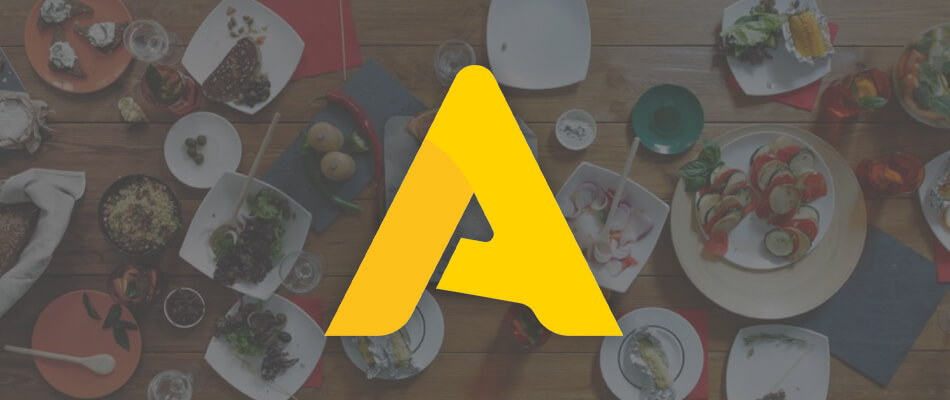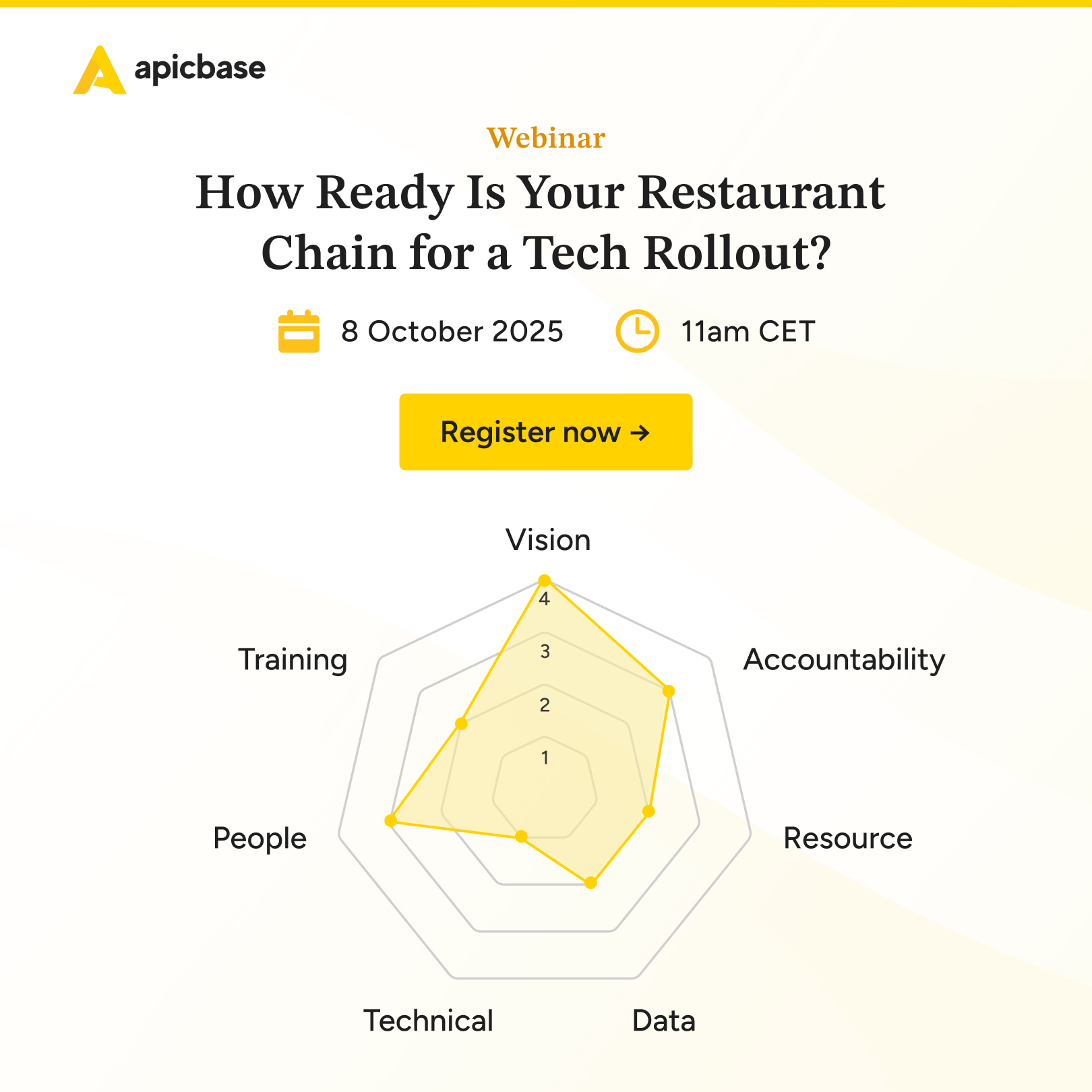Carl Jacobs, CEO and co-founder of APICBASE, sat down with Athol Dipple from the Fast Food Pro magazine for an interview discussing the future of food companies in the digital era.
At the beginning of June, I met the APICBASE team at the Commercial Kitchen Show in Birmingham. APICBASE developed the world’s first compact photo studio dedicated to food photography.
Besides that, the company also developed a cloud based food management platform to add ingredients to the pictures taken with APIC studio, automated allergen tracking, food cost calculation and so on. Sounds interesting, right? I sat down with Carl Jacobs, CEO and co-founder of APICBASE, to discover more about how he perceives the future of the kitchen.
In the next 5 years, all the food companies will have digitized their kitchen. The one’s who don’t, will fall behind. We are here to help them.
Carl Jacobs
CEO Apicbase
So, Carl, how did you come up with the idea of building a photo studio for the kitchen?
Originally, it was Michelin starred chef and co-founder of Apicbase Julien Burlat who came up with the idea of creating a photography tool to capture his creations in a quick and easy way.
As a high-profile chef with incredible taste for innovation, he continuously changed his menus in accordance to availability of products from the market and his customers, some of whom came in more than once a week.
So, whenever he created something new, he tended to forget what he had been doing in the kitchen before and he wanted to make sure that he had archive of everything he ever created, taken live, during service without losing time.
We came up with the idea of the photo studio, which turned out not to be such an easy task to build, if you take into account the enormous difficulties one faces when trying to find the right lighting and settings.
As I understood, this is only half of the story?
That is correct, the photo studio is part of a larger suite of products that we offer our customers in order to manage the back end of their kitchen in a much more efficient way.
So how does one get from a photo studio to being a full-fledged recipe management system?
Well, that’s a good question indeed! In the beginning, we set off with a very simple task in mind, build a photo studio to withstand the rigours of the commercial kitchen.
From the moment we started to engage with our customers, we noticed a huge demand for great digital tools to make the life of the chef easier in the kitchen. That’s when we started building our software based on customer insight and requests providing a bunch of tools that work seamlessly together.
That’s what makes our tools so handy: they’re really conceived from the point of view of the chef, from the basis of their creativity, and everything else that comes along: from allergen tracking on a single ingredient to total menu-based bills of material and food costing.
So how they work together, the hardware and software? Because now I see two distinct products that do two different tasks?
The great thing about our approach is that we have actually bridged the gap between visual and textual reporting. The images you take with APIC studio are immediately available to your team and they can be used as training materials, or you can tag your ingredients in the images and print those images with ingredients etc.
So, in this instance, the merger between images and text makes the saying “an image says more than a thousand words” actually true. We’re the only recipe management system in which a chef can work truly visually and that’s what they love about our system the most.
Why do you think visual aspect is so important?
Well Athol, we also eat with our eyes of course! We live in the social media age, Facebook, Instagram, Twitter are so present in our daily lives and our smartphones are stuck to our hands, it’s fundamentally important, for marketing reasons, to serve menu items attractively and to deliver them consistently.
Besides the marketing aspect, having a visual catalogue of your dishes and a step by step guide of your recipes, will help you train new team members. Since some food businesses have a high team turnover, this could really decrease the amount of training time and facilitate perpetual training.
All right, so when we met, you just won the silver medal at Innovation Challenge during the Commercial Kitchen show in Birmingham. How do you see innovation in the food industry?
To me, innovation is all about making sure that food producers, whether they’re small or big, have the tools at hand in order to provide customers with the best experience possible without enlarging their ecological footprint too much. Sustainability is a big thing for me.
The quest to make sure that everybody gets a good meal without destroying our planet is a huge deal, and if you can be part – however small that role is – to reducing this footprint and to maintain or improve current standards, I think you’re really contributing to the future of the food industry.
And what do you bring to the table in order to Innovate?
We help food companies to reduce that footprint I just talked about by enabling them to calculate their food stock in a very detailed way. As procurement can be very variable, we help them forecast how much they need to order and when.
For example, when your menu is calculated on 30 people, but you have a special occasion party for 50 extra people, it can be difficult to know how much you need to order from each ingredient. Because no chef wants a shortage of ingredients in the kitchen, the danger of ordering way too much food and thus having a lot of food left, can now be reduced.
Enter the number of people you’re cooking for and the software will automatically calculate the amounts you need per ingredient. Export them per supplier and you’re good to go. This way, it’s possible to reduce food waste.
What’s your opinion on food cost?
Food cost is a key measure for any company. Getting a grip on the food cost of your company, can save you a huge amount of money and can mean the difference between positive or negative results below the line.
For example, on each menu item or meal you prepare there’s a, let’s say, around 70% gross margin you’d want to reach.
Most fish are protected by catch limits and its price can vary greatly during the year, so if it gets more expensive, you’d like an alarm to go off to tell you that you won’t be able to reach the predetermined margins so you can make plans for this.
What are, according to you, the pain points in the food industry?
We see an enormous lack of digitisation in the kitchen. There is some digitisation in point of sales, purchase to pay, but we see a shortage in information management at the core of creative side.
As business grow it can be difficult to deliver their food creativity to a consistently high standard across multiple sites. Our studio and software can help them to deliver consistent excellence of the menu item.
What do you mean with digitisation?
Of course, manual craft skills remain one of the core values of the kitchen, and as a company we totally support the need for this.
What we see is that the kitchen lags behind in the use of digital tools to make life easier for chefs and other kitchen staff in order for them to spend more time developing new food items.
So how can digitization help your food companies then?
It’s all about scalability, and consistency.
Even when you’re a small foodservice operator, it’s worth spending some of your time trying to get hold of your intellectual property in a standardized way because whenever there is an opportunity to scale up, having spent some time building a digital footprint will help you achieve your goals.
That’s some good advice for our readers, Last question, where do you see kitchens evolve in the next five years?
I see more and more restaurant chains popping up, from healthy fast food chains to coffee shop chains. Although a lot of enterprises are struggling with it, scalability will be the future and to assure that your scalability is on point, all food companies will become digital. In next 5 years, all the food companies will have digitalized their kitchen.
The one’s who don’t, will fall behind. Unfortunately, food companies are not IT companies and if a company has its own IT department, then they probably do not have a data science team. We are here to help them.
Thank you so much for your time! Good luck in the future with APICBASE.
Thanks for meeting with me, it was a pleasure talking to you.



